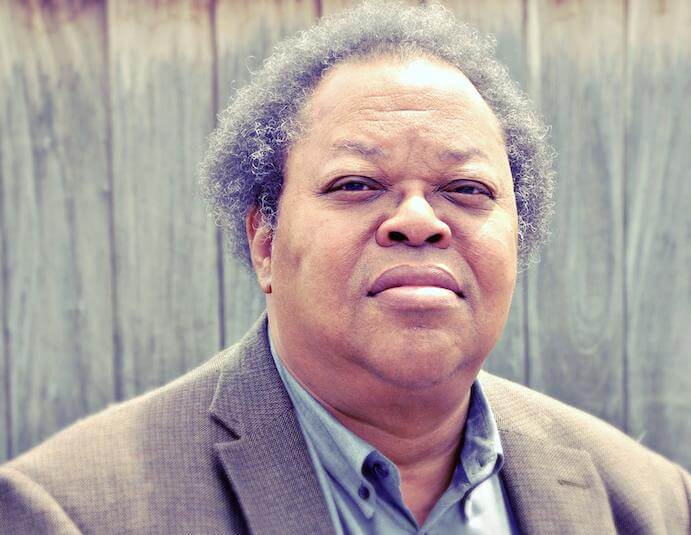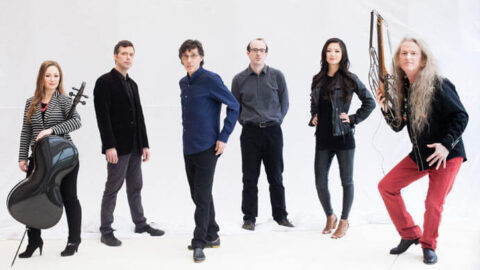Merkin Hall was completely packed on Thursday, February 15, 2018 for the Bang on a Can All-Stars 2018 People’s Commissioning Fund Concert, co-presented by New Sounds Live and hosted by the Ecstatic Music Festival. The evening’s offering included world premieres by George Lewis and Angélica Negrón, as well as pieces from past People’s Commissioning Fund concerts by Pamela Z, Annea Lockwood, Lukas Ligeti, and Thurston Moore. The Bang on a Can All-Stars are Ashley Bathgate (cello), Robert Black (double bass), Vicky Chow (piano and keyboard), David Cossin (percussion), Mark Stewart (electric guitar), Ken Thomson (clarinets), and Jody Elff (sound engineer).
The concept behind the People’s Commissioning Concert is admirable, and to make it a yearly tradition for over twenty years running is even more so. In the current landscape of grant-based and academy-funded composer commissions, it is refreshing and invigorating to hear new music that is financially supported by a community of individuals. And if there’s one thing to celebrate about Bang on a Can (other than the fabulous music), it is the warm sense of community: the vibe was something like a family reunion, with the house filled by students, founders, Bang on a Can Summer Festival alumni, composers and performers, and of course enthusiasts and supporters.
To kick off the concert, Pamela Z joined the All-Stars on stage for her piece The Schmetterling (1998). At twenty years old, Z’s piece was the oldest on the program. WNYC’s John Schaefer, who hosted the event, brought the composer on stage for some questions. “Do we need any explanation of the narrative in your piece?” he asked. “Oh no,” she replied with a smile. “It’s going to play out like National Geographic.” Z approached a motion-controlled electronics device center stage. As she began to flutter her hands and pull at the air around it, insectoid, alien sounds began to emerge. The ensemble entered with a walking bass and bowed piano and vibes, creating a wonky, bizarre scene. The vocal part alternated between a documentary-style narration about the Schmetterling—a strange, winged insect—and singing in a style reminiscent of nineteenth-century art song. For all of its quirks, Z’s piece was surprisingly effective, and had the audience laughing along with the twists in its narrative.

Annea Lockwood’s Vortex (2003) was written shortly after President Bush announced the start of the war against Iraq. Lockwood’s title came from her feeling that we had entered a vortex, one from which we may not have found our way out of yet. The piece began with a swirling and ominous void, generated from close mic’d tam-tams and the clanging hum of the “uboingee,” an electric guitar-hybrid instrument fitted with springs, created by Bang on a Can’s Mark Stewart. Over this, the cello and clarinet shimmered like the iridescent surface of oil, occasionally interrupted by violent clashes from the ensemble that echoed like gunshots. The piece ended in the same dark and spacious void in which it began, effectively conveying the inescapable pull of the vortex.
Lukas Ligeti’s Glamour Girl (2007) closed the first half. A drummer himself, Ligeti spoke of the difficulty that comes with reading a fully notated drum part—difficult for most drummers, that is. David Cossin conquered Ligeti’s gnarly writing for drum set with bravado, and stole the show with his explosive, adrenaline-fueled performance. At moments, the piece descended into murky, polyrhythmic complexity, only to emerge with dazzling sections of unified playing across the ensemble.
The first of this year’s two new commissions was George Lewis’ float, sting (2018). The title is of course a gloss on boxing legend Muhammad Ali’s famous quote, “Float like a butterfly, sting like a bee. The hands can’t hit what the eyes can’t see.” Lewis’ writing is cacophonous and energetic, with varying density of gestures serving as its main source of drama. Throughout the piece, tremolos, rattling percussion, and scraping piano strings pierced through the texture, acting as motivic beacons in a thick sea of material. The All-Stars met Lewis’s artfully feral writing with brilliant virtuosity and fiery drive.

The second new commission was Angélica Negrón’s Turistas (2018), which is based on a zine of the same name by Puerto Rican illustrator Mariela Pabón. Projected over the stage, pages from the zine portrayed the ignorant (and to varying degrees racist) commentary made by tourists to Pabón, who at the time worked at a small hotel in Puerto Rico. Negrón’s piece was delightfully kitchy and charming, as she blended elements from genres she grew up with like reggaetón and salsa with chirping electronics and reverb-saturated drums. She described her piece as an eyeroll to the people who ask her why her music doesn’t sound Puerto Rican—and in this way it was a very effective tongue-in-cheek response.
The concert closed with Stroking Piece #1 (2003) by Thurston Moore, of Sonic Youth. Moore’s piece began with an intimate guitar and drums duo, evocative of Sonic Youth’s distinct sound. As the ensemble joined in, riffing on the same harmonic progression, the texture shifted and the volume increased. “At some point,” Mark Stewart explained before playing, “everything explodes into either splendor or chaos, depending on your view.” And explode it did, with the band reaching a violent and deafening climax as they threw themselves with full force into their instruments.
The All-Stars sent the audience home with a bang, which is appropriate for an ensemble that in many ways successfully bridges the gap between contemporary classical and rock genres. The All-Stars are world-class performers that can not only handle anything thrown at them, but unabashedly make it their own. And the diverse offering of aesthetics and styles on this evening’s program is a testament to Bang on a Can’s celebration of artists who proudly stand out from the crowd.
























